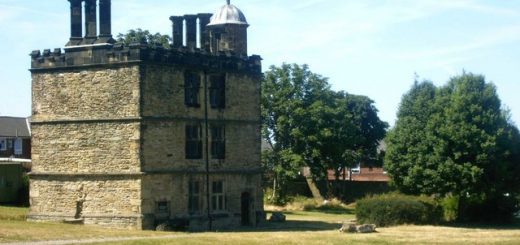St Vincent’s Church, Burton
St Vincents dates back probably to the Norman occupation with a church in Burton being recorded in the Domes Day Book of 1086 and the earliest recorded rector being Richard de Basingham in 1186. A strange occurrence was reported at the church during the first half of the 17th century when two men decide to hold a vigil in the porch of the church as was a common folk tradition associated with St Marks Eve (24th April).
 An account of their experience was passed to Colonel Gervase Hollis by a minister connected to the politician Sir Thomas Monson (1565 – 29 May 1641) of Burton. The following is taken from the Hollis manuscripts, in the Lansdowne Collection.
An account of their experience was passed to Colonel Gervase Hollis by a minister connected to the politician Sir Thomas Monson (1565 – 29 May 1641) of Burton. The following is taken from the Hollis manuscripts, in the Lansdowne Collection.
‘In the year 1631, two men (inhabitants of Burton) agreed betwixt themselves upon St. Mark’s eve at night to watch in the churchyard at Burton, to try whether or no (according to the ordinary belief amongst the common people) they should see the Spectra, or Phantasma of those persons which should die in that parish the year following. To this intent, having first performed the usual ceremonies and superstitions, late in the night, the moon shining then very bright, they repaired to the church porch, and there seated themselves, continuing there till near twelve of the clock. About which time (growing weary with expectation and partly with fear) they resolved to depart, but were held fast by a kind of insensible violence, not being able to move a foot.
About midnight, upon a sudden (as if the moon had been eclipsed), they were environed with a black darkness; immediately after, a kind of light, as if it had been a resultancy from torches. Then appears, coming towards the church porch, the minister of the place, with a book in his hand, and after him one in a winding-sheet, whom they both knew to resemble one of their neighbours. The church doors immediately fly open, and through pass the apparitions, and then the doors clap to again. Then they seem to hear a muttering, as if it were the burial service, with a rattling of bones and noise of earth, as in the filling up of a grave. Suddenly a still silence, and immediately after the apparition of the curate again, with another of their neighbours following in a winding-sheet, and so a third, fourth, and fifth, every one attended with the same circumstances as the first.
These all having passed away, there ensued a serenity of the sky, the moon shining bright, as at the first; they themselves being restored to their former liberty to walk away, which they did sufficiently affrighted. The next day they kept within doors, and met not together, being both of them exceedingly ill, by reason of the affrightment which had terrified them the night before. Then they conferred their notes, and both of them could very well remember the circumstances of every passage. Three of the apparitions they well knew to resemble three of their neighbours; but the fourth (which seemed an infant), and the fifth (like an old man), they could not conceive any resemblance of. After this they confidently reported to every one what they had done and seen; and in order designed to death those three of their neighbours, which came to pass accordingly.
Shortly after their deaths, a woman in the town was delivered of a child, which died likewise. So that now there wanted but one (the old man), to accomplish their predictions, which likewise came to pass after this manner. In that winter, about mid-January, began a sharp and long frost, during the continuance of which some of Sir John Munson’s friends in Cheshire, having some occasion of intercourse with him, despatched away a foot messenger (an ancient man), with letters to him. This man, tramling this bitter weather over the mountains in Derbyshire, was nearly perished with cold, yet at last he arrived at Burton with his letters, where within a day or two he died. And these men, as soon as ever they see him, said peremptorily that he was the man whose apparition they see, and that doubtless he would die before he returned, which accordingly he did.’
I am not how much of the existing church would have been in existence in 1631, during the time of the experience as it was extensively rebuilt during 1795, though the west tower and arch date from 1678.























Recent Comments